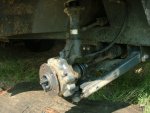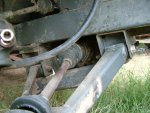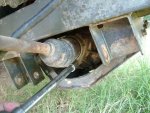This is an easy job. I will post these pictures a little at a time -I need to sort the pictures but the shaft is all put back together- I just waiting on the oil seal to come in before I'm completely through with it.
In the first picture you can just see the crack in the vein of the boot.
In the net picture, I've removed the tire ,removed the pin and am removing the axle nut.
In the third picture, I will proceed to remove the ball joint nut and tie rod nut and knock them out. I will also loosen the nut holding the strut on the knuckle case-but not remove it.I marked it's resting place on the knuckle case so if it moved, I could put it back exactly. Now I have a piece of wire ready to hold up the knuckle case and strut when I swing it out of the way. The wire is secured to the assembly and I swing it out of the way-while holding the axle with my hand. The axle comes out of the knuckle case easily and the assembly is tied out of the way. bordercollie
In the first picture you can just see the crack in the vein of the boot.
In the net picture, I've removed the tire ,removed the pin and am removing the axle nut.
In the third picture, I will proceed to remove the ball joint nut and tie rod nut and knock them out. I will also loosen the nut holding the strut on the knuckle case-but not remove it.I marked it's resting place on the knuckle case so if it moved, I could put it back exactly. Now I have a piece of wire ready to hold up the knuckle case and strut when I swing it out of the way. The wire is secured to the assembly and I swing it out of the way-while holding the axle with my hand. The axle comes out of the knuckle case easily and the assembly is tied out of the way. bordercollie















